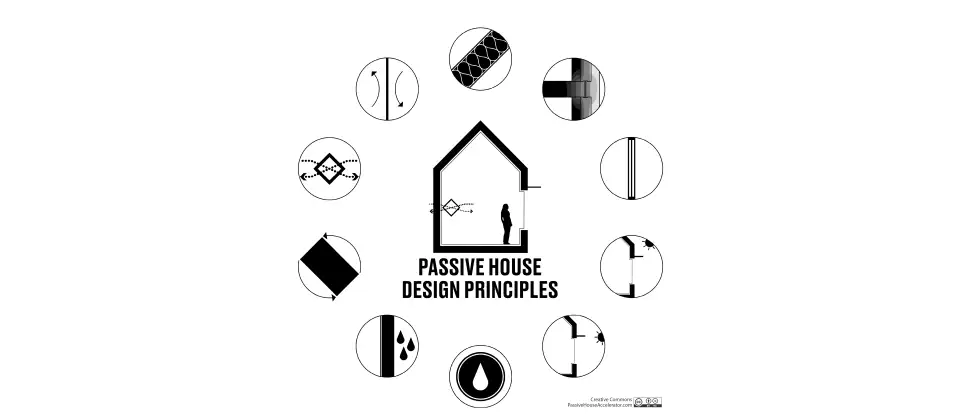
Passive House design empowers us to manage moisture, thermal transfer, air, and sunlight to create comfortable, healthy, super-efficient buildings. The “classic five” Passive House design principles—continuous insulation, thermal bridge-free design, airtight construction, high performance windows and doors, and filtered fresh air with heat recovery—are joined by the principles of shading, daylighting and solar gain, efficient water heating and distribution, moisture management in assemblies, and building orientation to create durable, high performance buildings where people can thrive. These principles guide both new construction and retrofits. Passive House Intro | Why: Passive House Benefits | What: Passive House Standards
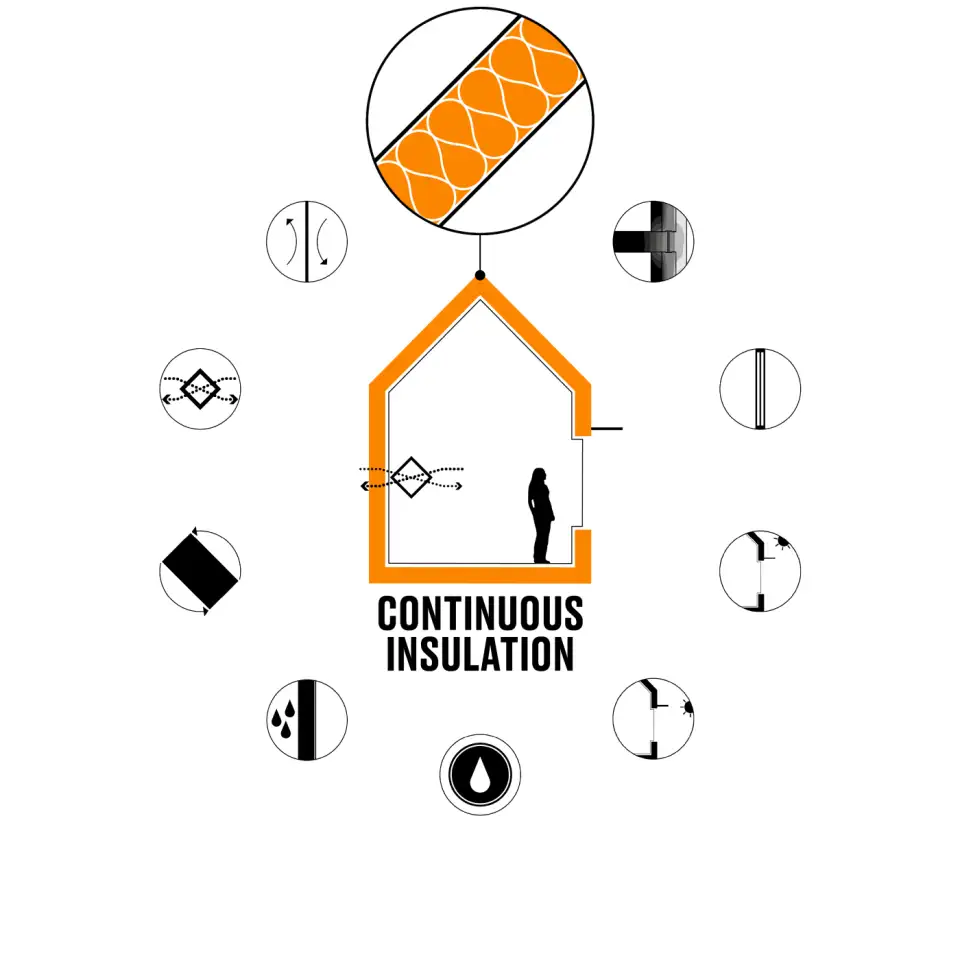
01 • Continuous Insulation
A continuous layer of insulation wraps Passive House buildings, keeping them warm in the winter and cool in the summer. Passive House designers also harness this insulative layer to prevent condensation inside the building and its assemblies.
Moisture: We design building assemblies so that their vapor profiles are appropriate for the climate, their drying potential is maximized, and they are protected from any moisture buildup. The insulation layer also keeps the inside face of exterior walls warm, preventing condensation on the interior surfaces of those walls during the winter.
Thermal Transfer: Because the insulation layer is continuous, it is free of weak spots that allow thermal transfer across the building envelope. Heat stays in during the winter and cool stays in during the summer.

02 • No Thermal Bridges
A thermal bridge is any building element that allows heat or cool to bypass a building’s thermal barrier. It’s like a hidden thief of thermal energy, undermining performance and durability. For example: a concrete floor that continues from inside to outside; a poor window frame; or a steel beam that penetrates an exterior wall. We eliminate thermal bridges by introducing thermal breaks into those assemblies—gaps or insulative elements that stop the flow of thermal energy through an assembly.
Moisture: A thermal bridge will increase thermal transmittance through an otherwise insulated layer that it penetrates, risking dangerous condensation that can result in rot, corrosion, and mold. Thermal bridge-free design avoids this moisture risk and makes buildings more durable.
Thermal Transfer: Thermal bridge-free design is critical to energy efficiency, thermal performance, and comfort. Not only do thermal bridges rob energy, they can also change interior surface temperatures, cause draft-inducing convection, and decrease occupant comfort.
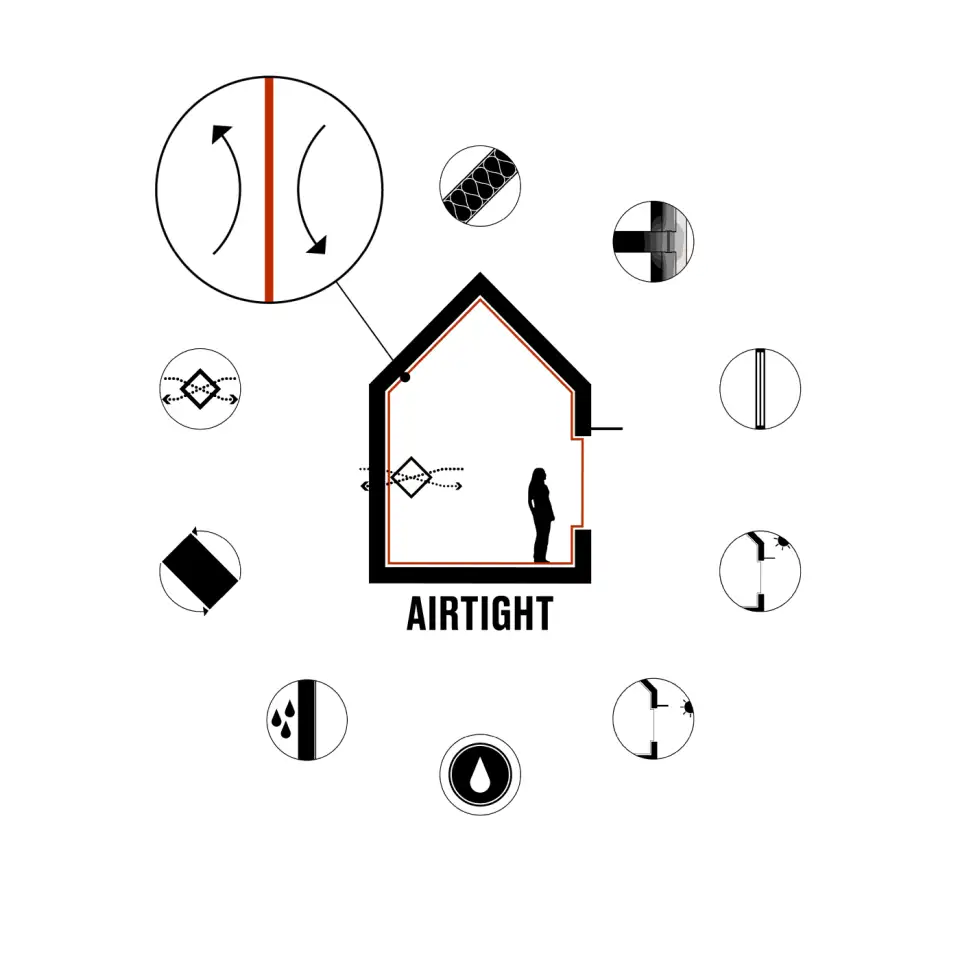
03 • Airtight
A Passive House building’s airtight layer is like a windbreaker, stopping air from penetrating to the inside. Establishing this unbroken air barrier is central to Passive House performance and durability. In design, we do the “red pencil test” to check that an air barrier line can be drawn around each cross-section of the building without the pencil ever leaving the paper. In the field, this air barrier is built through a combination of sheet membranes, fluid-applied membranes, tapes, and sealants that transition without interruption between components of the building envelope. Airtightness is verified with a blower door test, a key measure of performance and construction quality.
Moisture: Airtight construction protects building assemblies from dangerous moisture intrusion by preventing bulk water from driving in or airborne vapor from being carried in.
Thermal Transfer: By stopping the movement of air across the building envelope, the air barrier seals warm air inside in winter and cool air inside in summer. This is key to achieving ultra-low energy use, since air leakage represents wasted energy. Airtightness also boosts the efficacy of mechanical ventilation with heat recovery.
Air: Combined with the filtered, balanced mechanical ventilation of Passive House buildings, airtight construction improves indoor air quality, even during periods of intense outdoor air pollution. The air barrier stops polluted air from seeping through walls and ensures that all incoming air passes through the ventilation system where it is filtered before entering the building. This is particularly important in urban settings and in regions prone to smog or forest fires.
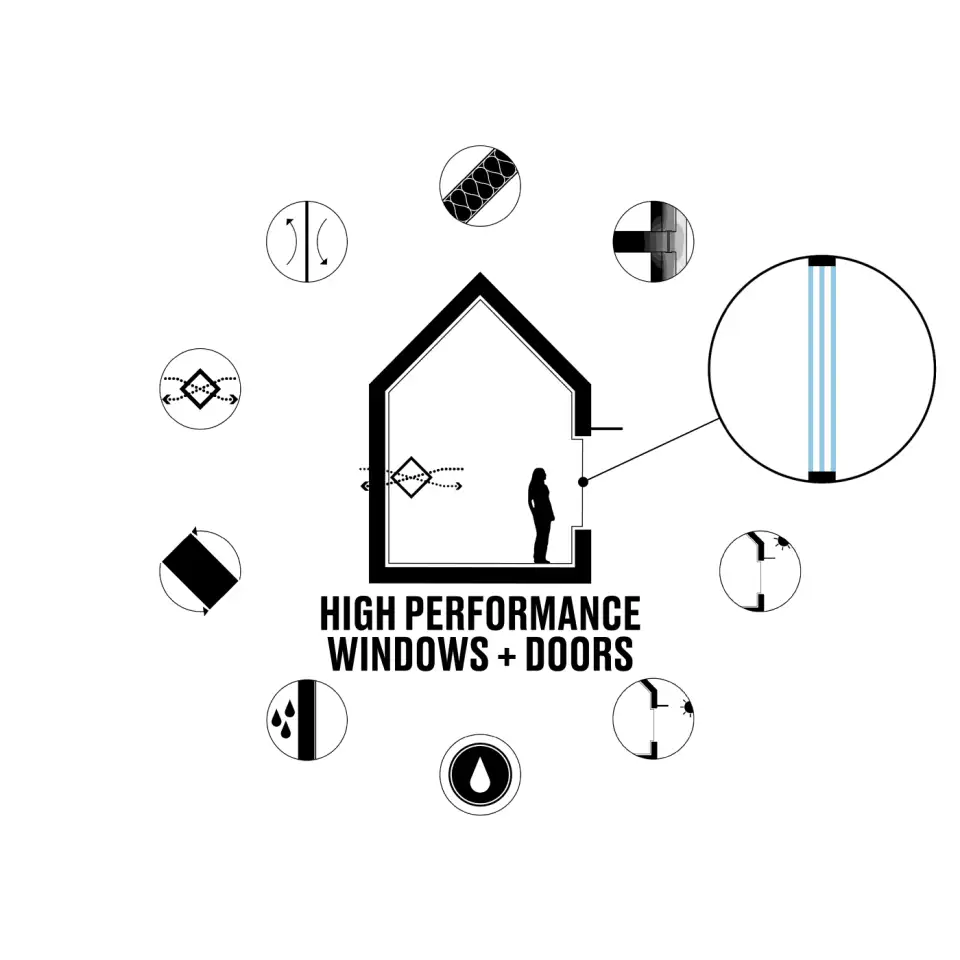
04 • High Performance Windows + Doors
With each window and door opening we make in a Passive House building, we are essentially punching a hole through an advanced wall assembly and its airtight, weather-resistant, and insulative layers. So, the performance of the windows and doors that go into those holes, and how well we tie them into the surrounding wall assembly, is mission-critical to maintaining the integrity of the Passive House building envelope.
Moisture: Well-installed high performance windows and doors repel wind-driven rain and facilitate safe outward drainage of any moisture. In the winter, high performance glazing units also ensure that interior glass surfaces stay warm, preventing condensation from forming inside.
Thermal Transfer: The thermally-broken insulated frames, warm edge spacers, triple glazing, coatings, and superior construction of high performance windows means their thermal resistance can easily best that of conventional windows by 3x. Given that a wall is only as good as its weakest link, this window performance is critical to a building’s overall thermal performance. In the winter, warm interior glass surfaces help maintain a comfortable and draft-free indoor environment.
Air: High performance windows are built airtight, so when integrated into airtight wall assemblies they become an extension of the continuous air barrier. Passive House windows can open like any other window, of course, so if it’s nice outside, open the windows!
Sunlight: We dial in the performance attributes of each window and door on a Passive House building to optimize solar gains appropriate for the climate and building typology. We capture solar gains when we want them and shield the building from solar gains when we don’t.
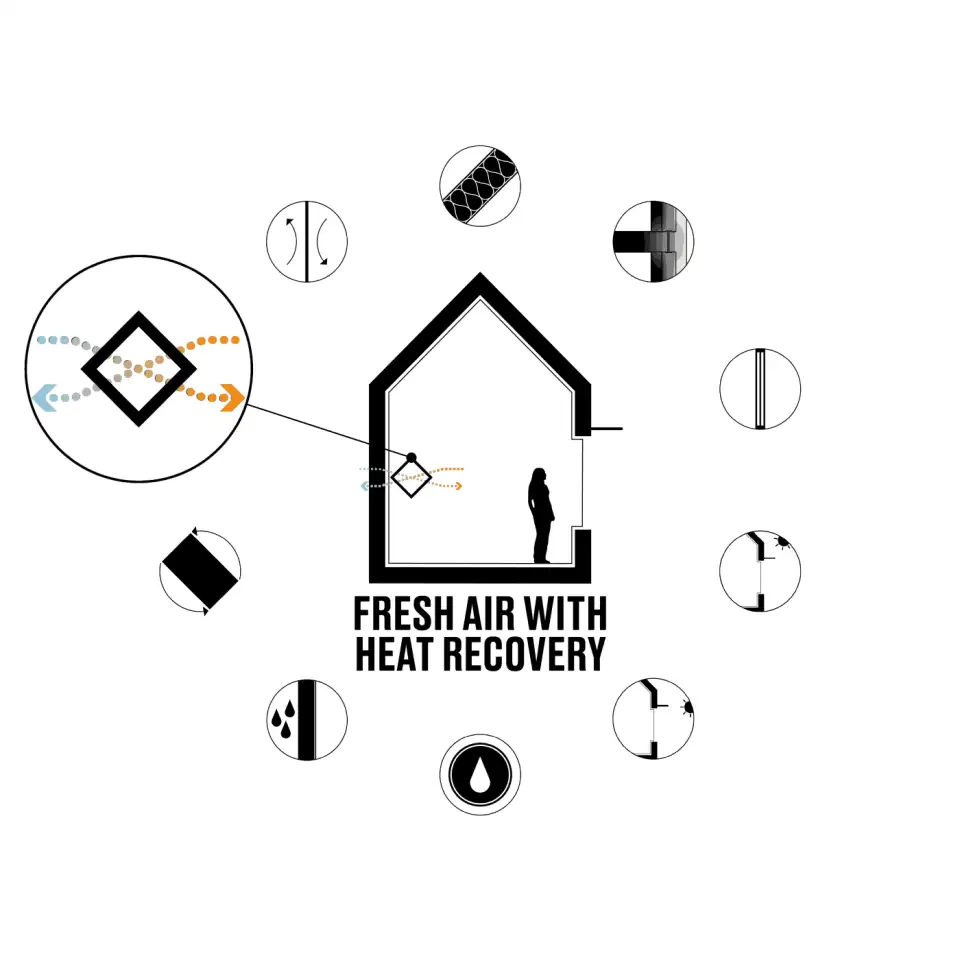
05 • Fresh Air with Heat Recovery
The delivery of filtered fresh air with heat recovery helps make Passive House buildings havens of clean air and energy efficiency. HRVs (heat recovery ventilators) and ERVs (energy recovery ventilators) are “balanced ventilation” components that supply a continuous stream of fresh air to living spaces while simultaneously extracting stale air, odors, and indoor pollutants from kitchens and bathrooms. Inside these devices, a heat exchanger—a honeycomb of straws that creates a very large surface area between air streams—allows heat energy in the outgoing air to passively transfer to and warm the incoming air without the two airstreams ever mixing. (In the summertime, the opposite happens, with cool outgoing air cooling the incoming air.) Filters in the unit remove pollen and pollutants, with pre-filters available to protect indoor air from intense outdoor pollution events.
Moisture: ERVs (unlike HRVs) can also transfer moisture between the exhaust airstream and incoming airstream. So, in humid climates, moisture in the outside air can be removed (transferred to the exhaust airstream) by the ERV before it enters the building. In dry climates, some of the indoor relative humidity can be preserved.
Thermal Transfer: Passive House-compliant HRVs and ERVs are extremely efficient at recovering heat, hovering around 90% efficiency for the best units. This is a key strategy in maintaining ultra-low heating and cooling energy.
Air: Properly filtered mechanical ventilation with heat recovery ensures good indoor air quality, regardless of the weather or air pollution conditions outside. Good airtight construction supports HRV and ERV efficacy by ensuring that air exchanges between inside and outside go through the device rather than seeping through leaks in the walls.
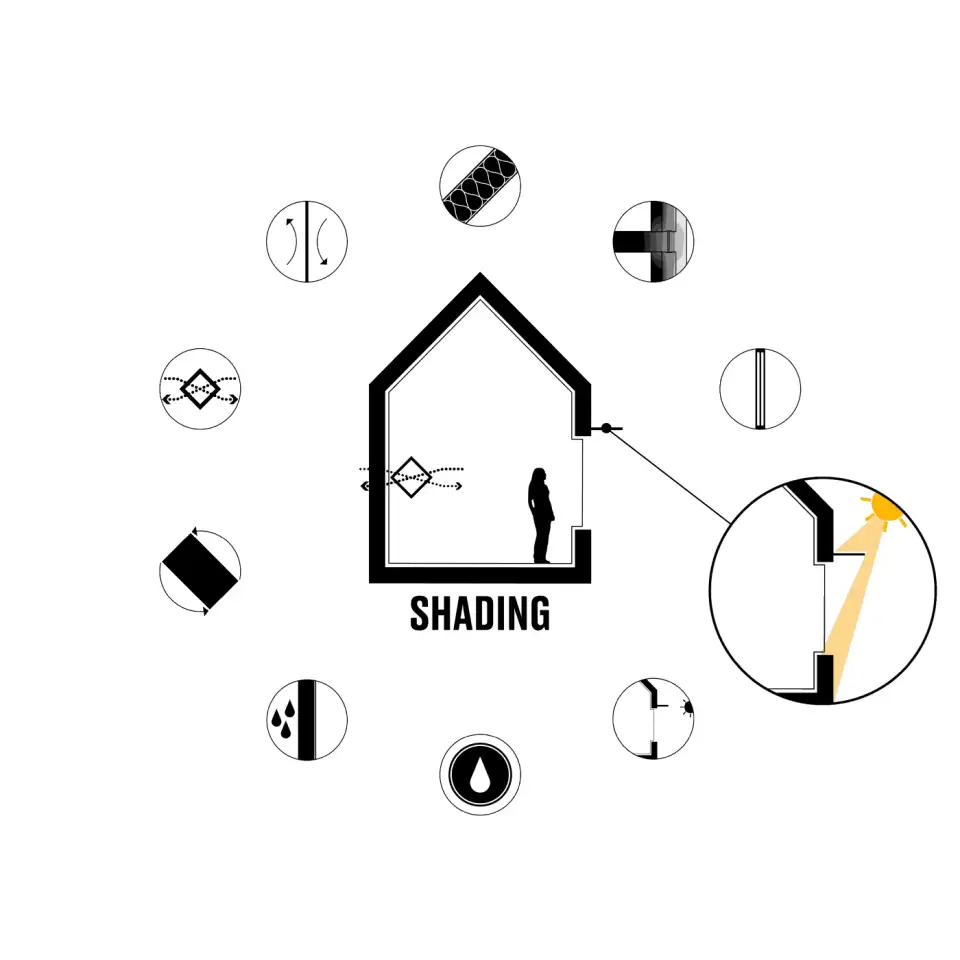
06 • Shading
While the “free” heat from solar gain may be a hot commodity in Passive House design, it must be managed with good shading to avoid too much heat gain during warm seasons. Deciduous trees are great for this, with their bare branches in winter and shade-providing leaves in summer. Architectural elements like overhangs can also play a role. So too, can window shades and screens, especially ones located at the exterior of the building.
Thermal Transfer: Shading manages heat gain from the sun, allowing designers to maximize the gain when the building needs it and minimize when it doesn’t.
Sunlight: Properly designed shading will not impede natural daylighting and can help prevent unwanted glare.
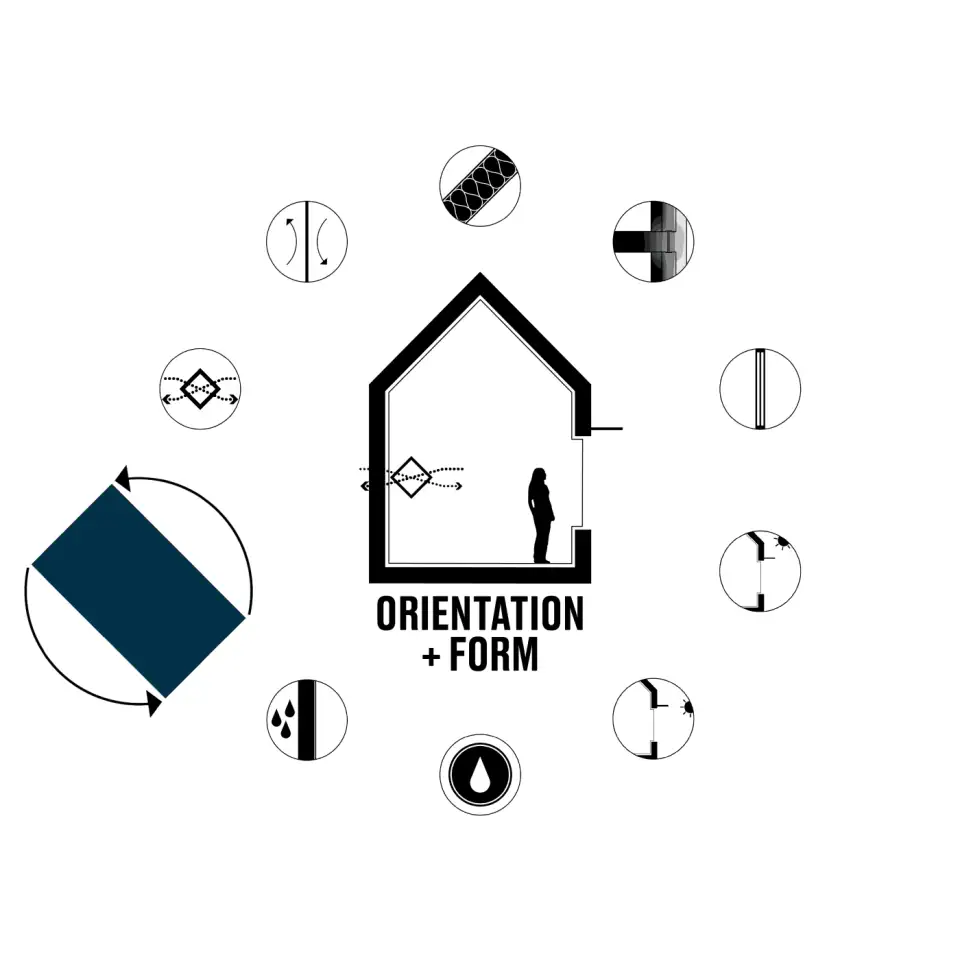
07 • Orientation + Form
Building orientation and form are fundamental design decisions that set the stage for how easy or difficult it will be for a building to achieve Passive House performance.
Thermal Transfer: When the site allows, we design the main axis and orientation of the building to optimize solar gains in a way that is appropriate for the climate and building typology of the project. The key is to orient the building in a way that will maximize that particular building's energy performance. As for building form, the simpler the form, the easier Passive House performance will be to achieve. The more zigs and zags, the more potential thermal bridges and the higher the surface area of the building becomes, requiring more and more insulation to counteract the extra thermal transmittance.
Air: A simple building form simplifies the air barrier, which makes airtightness easier to achieve.
Sunlight: We set the orientation of the building to optimize daylighting and solar gains appropriate for the climate and building typology.
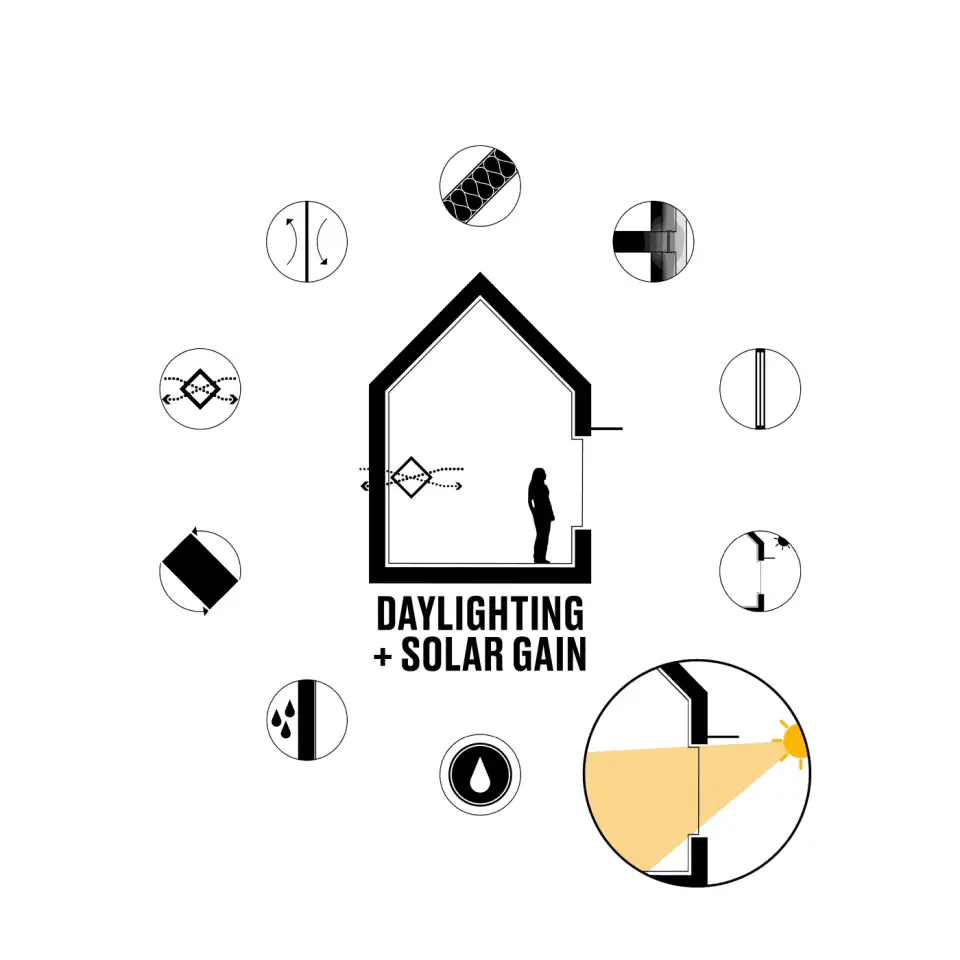
08 • Daylighting + Solar Gain
Natural daylighting and passive solar heat gain can provide energy “freebies” to Passive House buildings.
Thermal Transfer: For many buildings, solar heat gain—the heat energy captured in a building when sunlight shines through windows—can be an invaluable “free” resource in Passive House design. For other buildings, particularly ones that already have significant internal heat gains, big solar heat gains can be a liability. Passive House design allows us to optimize this based on climate and building typology through building orientation, shading, high performance window selection, and layout.
Sunlight: Natural daylighting reduces energy use for artificial lighting.
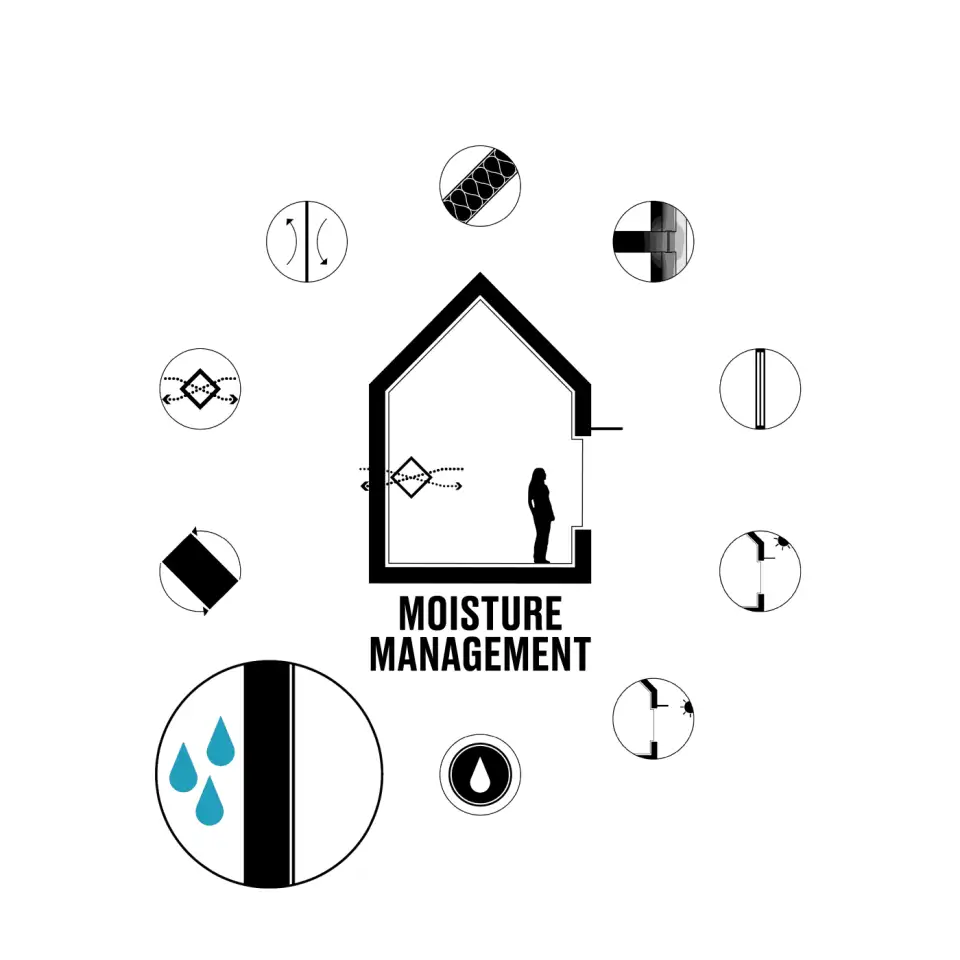
09 • Moisture Management
To ensure building durability, Passive House designers study how heat and moisture will behave in building assemblies in a given climate, and create designs that manage that behavior to avoid condensation risk and bulk water intrusion.
Moisture: The twin goals of moisture management are to (1) prevent bulk water intrusion into and (2) avoid condensation where it can harm building assemblies. Lots of components impact how heat and moisture flow through a wall assembly: the weather resistive barrier, the air barrier, vapor control layers, the structure, window openings, and more. The building’s climate zone impacts heat and moisture, too: whether the climate is cold and dry, hot and humid, or anything in between. Passive House practitioners draw upon hundreds of precedents and go-to assembly solutions to manage these variables. They also perform thermal and hygrothermal analyses using Therm, Wufi, Flixo, and other modeling software packages to confirm safe and durable performance and to guide design.
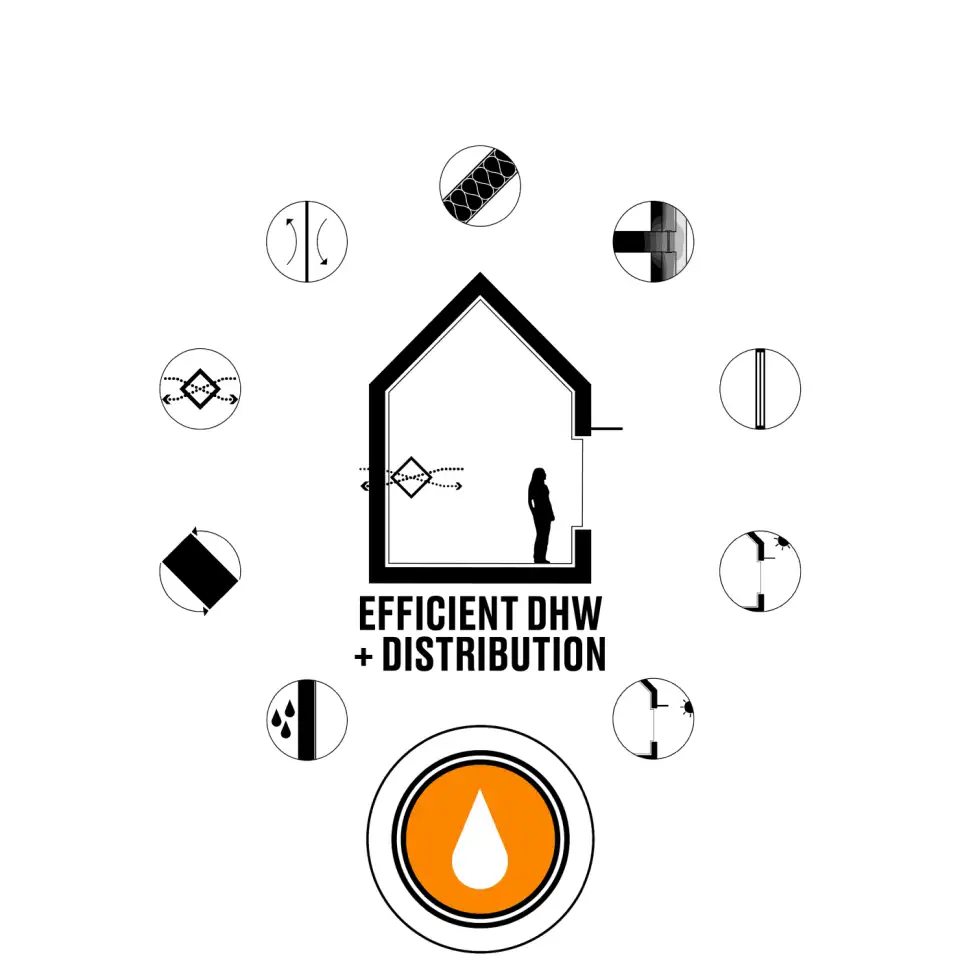
10 • Efficient Water Heating + Distribution
Because Passive House buildings dramatically reduce heating energy use, another source of energy consumption—domestic hot water—becomes a more conspicuous part of overall energy consumption. Energy-efficient water heating combined with efficient water distribution reduces this slice of the energy consumption pie.
Thermal Transfer: We start with a super-efficient water heater. Distribution lines are small diameter, well-insulated, and laid out to minimize pipe length between water heater and fixture. On-demand recirculating lines conserve water.